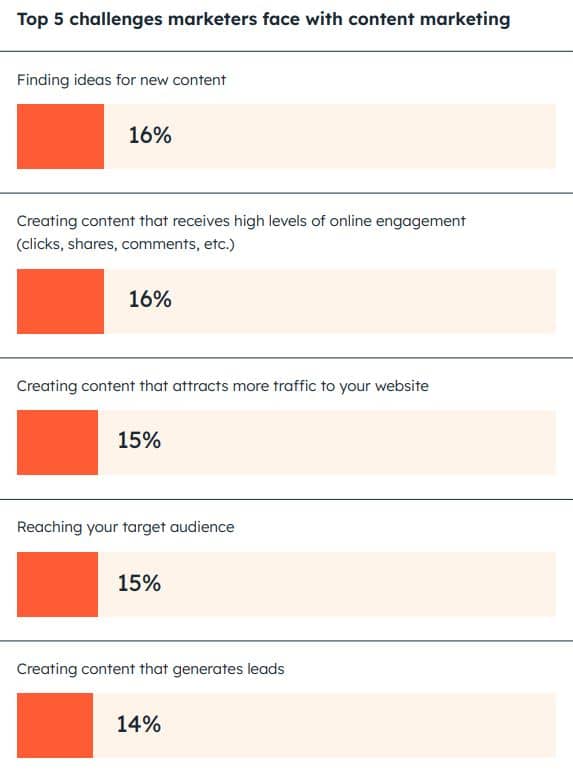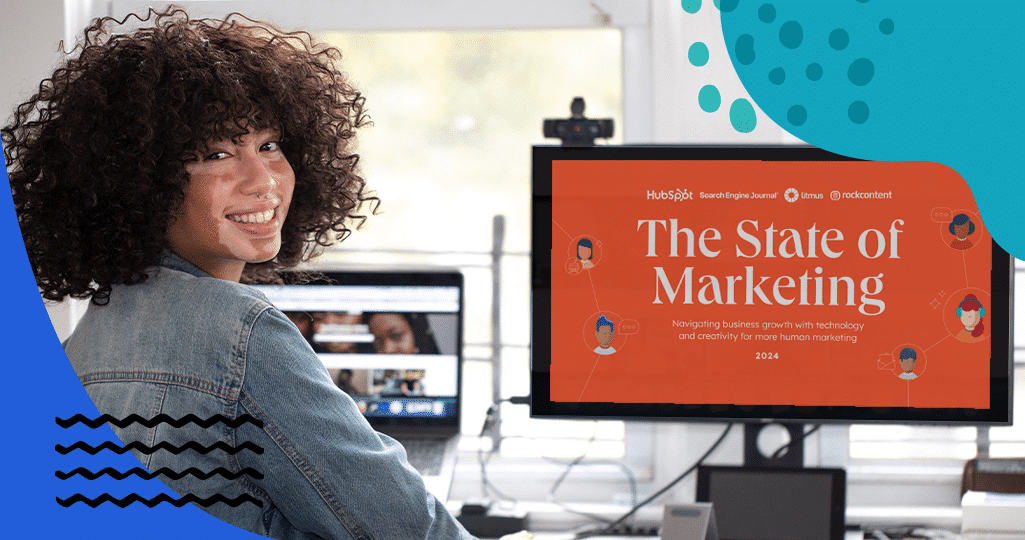If the digital landscape is a battlefield, content is a powerful weapon. But here’s the catch: your audiences are savvier than ever! Their attention spans are shorter, and search engines are prioritizing “helpful content” like never before.
This means your content strategy needs a serious overhaul, and personalization is the key to unlocking its true potential.
This article is the first in a series exploring key findings from the 2024 State of Marketing Report, a comprehensive study by industry leaders like HubSpot, Litmus, Rock Content, and Search Engine Journal.
Today, we delve into the future of content marketing, a future where personalization reigns supreme.
TL:DR
Search engines prioritize “helpful content” that addresses user intent.
Many marketers struggle to brainstorm new content ideas and generate engagement.
Content mapping: based on your research, create a plan with topics, formats, and channels that resonate with your audience.
Keyword research with a personal touch: target long-tail keywords that demonstrate specific user intent.
Generic titles and content get ignored.
Personalized titles that address specific needs grab attention.
Personalized content throughout the piece (examples, solutions) leads to higher engagement (clicks, shares, comments).
Personalized content targets specific segments within your audience (e.g., beginner hikers vs experienced hikers).
This attracts qualified leads who are already interested in what you have to offer.
Personalized content naturally aligns with E-A-T because it addresses a specific audience’s needs.
This increases the chances of your content ranking well in search results.
Dynamic Content: use website tools to deliver content based on user behavior.
Email Marketing Personalization: personalize subject lines, greetings, and content recommendations.
Generic content fails to connect with audiences and convert them into leads. Personalized content that addresses their problems and offers solutions fosters trust and lays the groundwork for conversion.
Clear calls to action: tell them what to do next (subscribe, visit product page, contact sales). Lead magnets: offer downloadable resources (ebooks, whitepapers) in exchange for user information.
Personalized landing pages: ensure landing pages are consistent with the content and offer a clear path to conversion.
Craft content that speaks directly to your audience’s hearts and minds. The future of content marketing is personal.
The Content Idea Crisis: Understanding Your Audience is the Cure
Imagine this scenario: you walk into a crowded marketplace, overwhelmed by a cacophony of shouts and hawkers vying for your attention. Everyone seems to be selling the same generic wares, their pitches blending into an indistinguishable noise. This, unfortunately, is a metaphor for the current state of online content.
The 2024 State of Marketing Report reveals a startling truth: the biggest hurdle for marketers is content ideation. A staggering 16% of respondents struggle to find ideas for new content. But the solution isn’t forcing random topics or resorting to clickbait tactics. The answer lies in understanding your audience – their needs, desires, pain points, and aspirations.

By creating content that directly addresses their specific concerns, you’ll generate a steady stream of relevant and engaging ideas.
Think of it like this: instead of shouting generic product features in the packed marketplace, you identify a customer with a specific problem and offer them a targeted solution. Suddenly, your voice cuts through the noise, and you have their full attention.
Here’s how personalization can help you overcome the content idea crisis:
- Audience Research: Conduct surveys, analyze social media conversations, and leverage website analytics to gain deep insights into your target audience. What are their interests? What questions do they keep asking? What challenges do they face?
- Content Mapping: Based on your audience research, create a content map that outlines topics, formats, and distribution channels that will resonate with them.
- Keyword Research with a Personal Touch: Don’t just rely on broad keywords. Look for long-tail keywords that demonstrate specific user intent. These “micro-niches” present golden opportunities to create highly personalized content.
Engagement Enigma: Personalization Sparks Interaction
Generic content gets ignored. Period. It blends into the background noise of the digital marketplace, failing to capture attention or generate any meaningful response. But personalized content that speaks directly to your audience’s needs sparks action.
The State of Marketing Report highlights another significant challenge for marketers: creating content that receives high levels of online engagement. A staggering 16% of respondents struggle with this aspect. Here’s where personalization comes to the rescue.
Imagine you create a blog post titled “5 Ways to Improve Your Home Cooking Skills.” This generic title might attract a few clicks, but it lacks the personalization needed to truly engage. Now, consider these alternatives:
- “Level Up Your Weeknight Dinners: 5 Easy & Delicious Recipes for Busy Professionals” (targeted to busy professionals)
- “Master the Art of Baking: A Beginner’s Guide to Creating Perfect Pastries” (targeted to baking novices)
- “Healthy on a Budget: 5 Affordable Meal Prep Ideas for Fitness Enthusiasts” (targeted to health-conscious individuals)
These personalized titles immediately grab the reader’s attention because they address specific needs and interests. This personalized approach continues throughout the content itself. You use relevant examples, address common pain points within that segment, and offer solutions tailored to their specific situation.
The result? Increased engagement in the form of clicks, shares, comments, and even direct messages from interested readers.
Read also: How to Create Content That Will Rank in 2024
Traffic Triumph: The Power of Personalized Attraction
The days of relying on broad keywords to attract website visitors are fading. Search engines are becoming increasingly sophisticated, prioritizing content that not only matches search queries but also demonstrates relevance to the user’s intent.
Personalization allows you to target your content to specific audience segments. This laser focus attracts the right kind of traffic – potential customers who are already interested in what you have to offer.
Here’s how it works: Imagine you’re a company selling hiking gear. Using a generic keyword like “hiking boots” might attract a broad audience, including casual walkers and fashionistas looking for trendy footwear.
But by personalizing your content, you can target specific segments within the hiking community.
- Create content for experienced hikers: Focus on technical gear reviews, challenging trail recommendations, and tips for advanced techniques.
- Develop content for beginner hikers: Gear guides for first-time purchases, tips on choosing the right trails, and essential safety information.
- Cater to specific hiking interests: Create content for backpackers, day hikers, or enthusiasts interested in specific terrains like mountain climbing or desert hiking.
This targeted approach attracts qualified leads. They’re already interested in hiking and actively seeking information relevant to their specific needs. By providing valuable, personalized content, you establish yourself as a trusted resource and increase the chances of converting them into loyal customers.
How Your Content Can Meet Google’s E-E-A-T Expectations
Google’s latest March 2024 core update emphasizes prioritizing content that is helpful, informative, and demonstrates expertise.
This focus on quality aligns perfectly with the concept of personalized content marketing. When you create content that addresses a specific audience’s needs and pain points, you’re inherently crafting informative and helpful pieces.
Google’s algorithms are likely to favor this personalized content as it demonstrates a deeper understanding of the topic and caters directly to user intent. By prioritizing personalization, you’re not just creating content that resonates with your audience, you’re also creating content that resonates with Google’s ever-evolving search engine ranking factors.
On an expert note, I anticipate potential impacts on content rankings and results, depending on how you create content.
Net: now is the time to act within the 2-month window provided by Google to ensure you are creating content that is trustworthy, authoritative, and truly helpful for your audience. The E-E-A-T guidelines (experience, expertise, authoritativeness, and trustworthiness) are more important than ever before.
Read also: Google March 2024 Core Update: Low-Quality Sites Being Deindexed
Here are a few tips:
- In Google’s own words, “avoid creating search engine-first content.”
- Build a robust Creative Brief for your brand and audience for customization of your content.
- Request bylines on 6-star orders.
- Rely on the team at WriterAccess for talent recommendations of our best writers in each industry or niche.
- Meet with writers ahead of time on our Conference Call tool to ensure alignment with your target audience.
- Be careful with the overuse of AI-generated content or AI tools.
WriterAccess talent creators are trained and ready to create meaningful content based on your brand and audience’s needs. In other words, content that ranks!
Reaching Your Right Audience: Personalization Cuts Through the Noise
Imagine again that crowded marketplace where everyone is yelling the same message. Search engines are flooded with generic content, making it difficult for users to find what they’re truly looking for.

Personalization lets you cut through the noise and reach your target audience directly. By speaking their language and addressing their needs, you become a beacon they can’t ignore.
Here are some personalization techniques to reach your right audience:
- Content Segmentation: Divide your audience into distinct groups based on demographics, interests, and online behavior. Then, tailor your content to resonate with each segment.
- Dynamic Content: Use website personalization tools to deliver content that adapts based on user behavior and preferences. For example, a returning visitor might see a different blog post than a first-time visitor.
- Personalization in Email Marketing: Leverage user data to personalize email subject lines, greetings, and content recommendations. This increases engagement and click-through rates.
Lead Generation Liberation: Personalization Converts
Content that resonates generates leads. However, generic content often fails to connect with audiences on a deeper level, leading to a disconnect between content and conversions.
The State of Marketing Report highlights another key challenge: creating content that generates leads (14% of respondents). When you create personalized content that addresses your audience’s specific problems and offers valuable solutions, you’re nurturing trust and laying the groundwork for conversion.
Let’s revisit the hiking gear example. Imagine a potential customer reads your personalized blog post titled “Top 5 Backpacks for Weekend Hiking Adventures.” The article addresses their specific needs, provides in-depth reviews, and offers clear purchasing advice. This personalized approach fosters trust and positions you as an expert.
Now, consider these additional steps to move them further down the conversion funnel:
- Include clear calls to action: Tell your audience what you want them to do next, whether it’s subscribing to your newsletter, visiting your product page, or contacting your sales team.
- Offer lead magnets: Provide valuable downloadable resources like ebooks, white papers, or discount codes in exchange for user information. This allows you to capture leads and nurture them with targeted marketing messages.
- Personalize your landing pages: Ensure your landing pages are consistent with the content that led the user there. Reinforce the personalized message and offer a clear path to conversion.
Conclusion: The Personalization Imperative
The 2024 State of Marketing Report paints a clear picture: personalization is the future of content marketing.
By prioritizing your audience’s needs and creating content that resonates on a personal level, you’ll not only stand out in the crowded online space, you’ll generate leads, boost engagement, and achieve your marketing goals.
So, ditch the generic approach and start crafting content that speaks directly to your audience’s hearts and minds. The future of content marketing is personal, and it’s time to embrace it.







